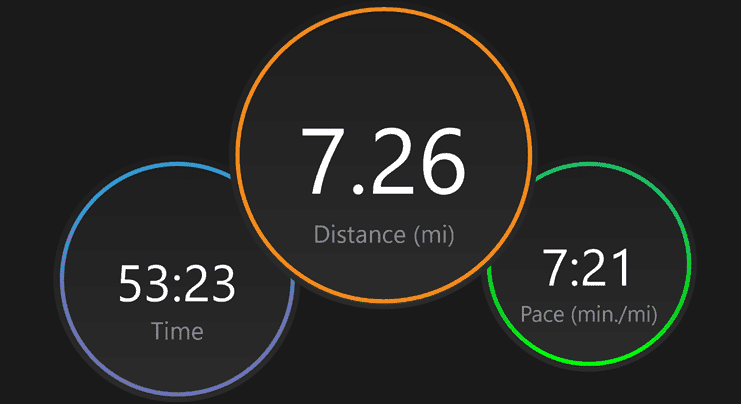How to Choose When to Run for Time or Distance?
There are two ways to track your distance running training, by time or by distance. If you are training at the proper pace for your fitness level, neither method is drastically different. The trick is finding the correct speed to run each workout to reach optimal performance.
The more standard training method is to go for measurable length (i.e., 12-mile long run, 400-meter repeats, or 3-mile tempo run). Running for distance allows you to be more quantitative and easily track data about your run. However, total mile goals will usually lead to accelerating and running harder as the finish line comes into sight. Time goals are discontinuous and tend to result in a smoother pace throughout the run. Certain situations make running for time or distance more beneficial and efficient than the other.
Running for Time
Most runners will tell you that running for a total number of minutes allows for a more flexible schedule around all their other life commitments. Many athletes and coaches may switch to time goals during the off-season to reduce the volume of running miles. In general, a total minutes goal focus will improve perceived effort while running. Running for time enables you to run on how you feel. It allows you to carefully monitor your breathing rate and the amount of fatigue in your legs to determine your pace and effort.
Individuals new to running or returning to running will find time goals more holistic and enjoyable. For example, programs such as Couch to 5K or Walk to Run incorporate short bouts of running followed by walking. The gradual increase in run time duration over an 8-10 week training period makes it easier to see and feel the positive results of getting back into shape.
Running for time is also perfect for those days when you may not be feeling your best. For example, try going out for a 30-minute run instead of focusing on reaching 3 to 4 miles. This total minutes of running focus will help not wreck your ego or force you to do too much instead of pushing through, not feeling good to reach a certain number of miles. You now have allowed yourself to focus on a pace and effort that is more realistic.
Suggested Time-Based Workouts:
Tempo Runs
Tempo runs are one type of workout where time goals make much more sense. The purpose of a tempo run is to run close to your lactate threshold for a specified period. Throughout a distance running training program, you will gradually increase the amount of time to sustain lactate pace.
Lactate threshold is a comfortably hard running pace that you can continuously hold for 60 minutes of running.
If you are new to tempo runs, start with a short duration of 10 to 20 minutes at the lactate threshold. Make sure to include a proper warm-up and cool-down with every tempo run workout. A tempo run is typically going to run at 20 to 30 seconds slower than your current race pace.
The lactate threshold can be a challenging pace to get correct. Without getting too technical, threshold pace is the effort level just below your body’s ability to clear lactate, which is a by-product of metabolism. At this pace, you can no longer keep up with lactate production, which leads to fatigue. Too slow on a tempo run, and it will just be another endurance workout. Too fast on a tempo run, then you might as well be running a race.
Find the correct pace, and your performance levels can soar with tempo runs in your training routine every 7 to 14 days. With distance running training, you will be able to extend your total minutes spent at the lactate threshold to 30 to 40 minutes. You should always finish a tempo run feeling like you could have sustained the pace for another 5 to 10 minutes. Pushing for longer than 40 minutes during a tempo run is unnecessary as this results in feeling more like a race pace effort than a proper training workout.
Steady-State Run
A steady-state run is a workout where you are maintaining a slightly slower pace than your lactate threshold. On average, this pace will be 30 to 45 seconds per mile slower than your race pace. It is what run coaches would call an easy to medium-paced run or perceived effort. An excellent steady-state run will improve your body’s ability to remove lactate. Finding the correct steady-state pace should never push your body to accumulate too much lactate, leading to fatigue before you reach the end. Steady-state runs can also provide a confidence booster for your ability to remain relaxed over a more extended period. This confidence will quickly translate to race pace efforts when it matters most.
To add a steady-state run workout to your training routine, start with 20 to 25 minutes at a constant pace. Always include a proper warm-up and cool-down period before beginning the steady-state portion of the session. Runners training for shorter long-distance races (i.e., 5K to half-marathon) can eventually build up to steady-state runs of 40 to 60 minutes at the goal pace. For runners focused on marathons or more extended distances, steady-state runs may reach 70 to 90-minutes spent at the goal pace. You should always finish a steady-state run feeling like you could have sustained the rate for another 10 to 20 minutes.
Running for Distance
Most of us will automatically default to running for a certain number of miles because we have picked out a goal race with a set length. Running for an overall distance can help us to focus more on the pacing aspect of a run. As we get closer to each workout’s finish, our minds receive constant visual feedback. This feedback allows us to process how much energy we can give to reach the finish quicker. However, many of us will fall into the habit of attempting to complete every run with a kick. If you feel this fresh at the end of an effort, then on your next run, set out at a little quicker pace rather than further developing this habit. When training, don’t be afraid to finish knowing you had a bit more to give. Leaving some energy in the tank will help carry your routine from day to day.
Suggested Distance-Based Workouts:
The Weekly Long Run
Running for total miles rather than time is most common when completing your weekly long runs. The long run is part of every distance runner’s training plan. It is how we gauge our progress toward our goal race. For example, most marathon training programs will start at a long run of 6 to 8 miles and progress to at least one run of 20 miles or more in length. Having experience running at the right pace for a length of miles close to your goal race is essential for several reasons.
- As your prolonged run miles increase, you are teaching your body to be more fat-adapted and enlarging your glycogen stores.
- The gradual progression in your long-run miles will also lead to improved musculoskeletal durability.
- Your long runs will increase resistance to mental fatigue and fill you with confidence on race day.
Those that have hit the wall in the final 5K to 10K of a half marathon or marathon will know all too well the importance of progressing your long-run miles at the correct pace. Even a slight change in energy systems can spell disaster both physically and mentally well before the finish line ever comes into sight. Adding variations to your long runs such as a fast finish long run, can keep you from boredom, develop mental toughness, and have you running faster times over any long-distance running event.
Speed Workouts
All runners should try to incorporate some speed workouts into their training routine. Why? Because speed workout sessions with intervals between one and six minutes (400 to 1600 meters) will effectively raise your VO2 max. A higher VO2 max level equates to your body being able to consume oxygen more quickly. Thus, supplying your muscles with the necessary oxygen they need to sustain a higher intensity of running for a longer duration.
VO2 max is the measurement of the maximum amount of oxygen that an individual can utilize during intense or maximal exercise. It is one factor that may help determine an athlete’s capacity to perform sustained exercise.
The tricky part with speed workouts is determining what pace to run. The simple answer is to run intervals of 400 to 1600 meters at a speed that you could only sustain for 10-15 minutes. However, this does not necessarily take into consideration your race goals. It also does not address your body’s natural tendency to be an individual more suited for speed or endurance. Some online pace calculators can help you determine the right pace for your speed workout intervals.
As with all harder-paced workouts, remember to give a period for an appropriate warm-up and cool-down. Also, don’t overdo it with speed workouts. An experienced half-marathon or shorter-distance runner may handle two sessions every 7 to 10 days. However, for the average runner or long-distance runner, one session every 7 to 14 days is all your body needs to see the physical adaptations. A good strategy is to alternate weeks between a distance-based speed workout and a minutes-based tempo run. This schedule change will help you to reach optimal performance levels much more quickly.
Race Pace Workouts
The final suggested workout by distance is the race pace workout. Race pace workouts follow the general rule of specific adaptation to imposed demands (SAID). In other words, what you train for is the particular outcome that you will get. If you want to run a 3-hour marathon, you have to spend longer running at that 3-hour, 6:52 per mile pace.
The exact structure of a race pace workout is going to depend mainly upon the length of your goal race. Regardless, the concept is the same. Half-marathon and marathon runners should start at a total number of miles they know they can achieve at a race pace. Schedule the workout every few weeks in your training. For each run, add a half-mile to a mile to the total distance. Marathoners usually will not progress race pace workouts past 10 to 15 miles. In comparison, half marathoners may move to 8 to 10 miles in total distance at a race pace. For 5K and 10K runners, the race pace will be much closer to the lactate threshold.
For 5K and 10K runners, the race pace will be much closer to the lactate threshold. Therefore, the total mileage at race pace in workouts is going to come in smaller amounts. The 10K runner may find two or three-mile repeats at the race pace beneficial. They also may incorporate ladders at race pace, going 2-mile, 1-mile, and 800-meter with equal rest between each race-paced effort. For the 5K runner, race pace workouts look more like speed workouts with distances of 800 meters, 1000 meters, and 1200 meters. The key is that the 5K runner is doing these at race pace and not exact VO2 max, thus building confidence for the race itself.
Conclusion
In the end, there is no hard science to say that running by time or by distance is better than the other. Both methods will give you satisfactory results. It is important to remember that there are workouts when it is appropriate to run for total miles, and there are workouts when it is suitable to run for time (Read About Training Paces). Building your training plan to incorporate both running styles is the best way to reach optimal performance for your exact race. A training routine is thought of as more than one week. Outline your training blocks (2-4 weeks) in a planned schedule to allow for proper recovery between time and distance-based workouts.
A Training Plan that Works for You.
Our collection of running plans will help you train year-round. From 5k to a 100-mile ultramarathon, we have a training plan built for your experience level and goals. Every plan is delivered via Final Surge, allowing you to sync workouts across devices, receive daily reminders of workouts and activities, and analyze workout and target zone details. Get started today with a training plan built for you, view our running plans here.









